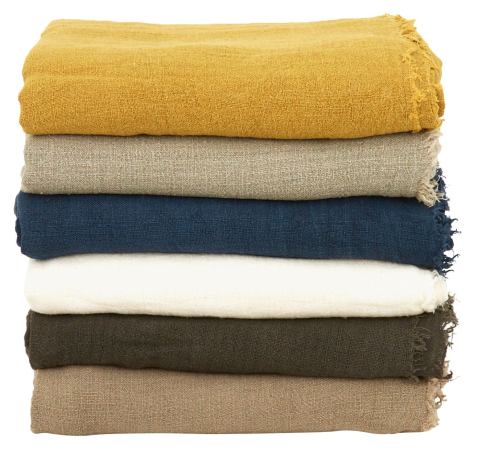We may earn revenue from the products available on this page and participate in affiliate programs.
Everyone loves a fluffy down comforter—I mean, what else makes a hotel bed so delicious? But if designers have anything to say about it, voluminous beds have had their reign. Despite the undeniable allure of feathers, the proverbial blanket of clouds is out; coverlets, in both residential and hospitality projects alike, are the latest go-to.
Designers we’ve admired forever, like Belgian minimalist Axel Vervoordt and the more traditional Brit Rose Uniacke, are known for making beds in such sleek fashion, but it seems only recently that the technique has come to dominate our social feeds. Designer Sebastian Zuchowicki filled the guest rooms at the Jersey Shore’s highly Instagrammable James Bradley Hotel with heavy linen coverlets, creating a particularly dramatic look by setting them in front of textured limewashed walls. If you’re getting European vibes, you’re onto something; Zuchowicki’s inspiration came from 1950s Italian homes. “I wanted to play with the effortless look and casual way of living that people cherished back in the day,” he says. Talk about a dreamy beach vacation.

The Styling Tenets
There’s more to it than just throwing a coverlet onto a bed; specific styling moves will get you the elegant, almost old-world look. For one, you’ll have to find a place to store extra pillows; you’ll just need two, and even those will be hidden. Tuck them under the coverlet to create a smooth sea of fabric. Some examples we’ve seen add a single boudoir or lumbar pillow on top. To get the elongated pooling effect on the floor, you’ll want to purchase one size larger than the bed. And while there’s certainly a time and a place for tall beds, the style works best on lower ones.
If you’re worried about stepping (or potentially slipping) on the top layer, simply tuck part of the fabric in, suggests designer Colin King. “Sometimes if there is a footboard or a really beautiful platform that I want to feature, I’ll tuck the cover under the end of the mattress and let the sides drape over,” he shares. Another thing you shouldn’t have to worry about? Wrinkles. The bedding collection he designed in collaboration with Cultiver is meant to be heavy enough to combat unwanted folds. “Pulled taught even over a duvet, the bedcover sits quite flat and is forgiving when it comes to creases,” he notes.
The Stay Comfy Secret


The real duvet lovers out there may be wondering: Is this comfortable for sleeping? If designer Augusta Hoffman—known for natural yet refined interiors—is designing it, then yes, it is. Her secret is to layer a heavyweight bedspread over a duvet; that way you still get the weight of a comforter, but it’s fully concealed. She says this simplifies the bed-making process, too; linens no longer have to be ironed and perfectly tucked underneath.
The Best to Buy
When it comes to shopping for the right coverlet, there’s no shortage of options out there. Hoffman uses one by Ruemmler for winter: “It is a really nice raw canvas that softens over time and is very forgiving with wrinkles.” In summer, she pulls out her gauzier Jayson Home bed cover, which comes in a range of earth tones.
Fenn Bedcovers
Jayson HomeOversized King Cotton Coverlet
RuemmlerThrowing any of the ones, below, onto your bed is a sure shot for the rustic, laid-back look in your very own bedroom.


















